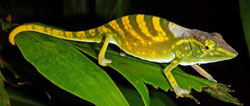A new chameleon species from Madagascar on the brink of extinction – “A tarzan yell for conservation”

Male holotype of Calumma tarzan, stress colouration fully developed. Copyright Frank Glaw<br>
The species was discovered in a small rainforest fragment very close to the village formerly known as Tarzanville. “Therefore, we dedicated the new species to the fictional forest man “Tarzan” in the hope that this famous name will promote awareness and conservation activities for this apparently highly threatened new species and its habitats, Madagascar's mid-altitude rainforest”, says PhD student Philip – Sebastian Gehring, first author of the description of this new species.
The Tarzan – chameleon should be considered as “Critically Endangered” because its recent distribution area covers probably less than 10 km2, there is continuing decline in the extent and quality of much of its habitat, and none of the habitats are included in the network of protected areas yet. The known habitats of this new chameleon should be protected as soon as possible in order to ensure the survival of this splendid species and other locally endemic endangered amphibian and reptile species occurring in these forest remnants, thereby using the Tarzan chameleon as a flagship species.
Source:
Gehring, P.-S., M. Pabijan,, F. Ratsoavina, J. Köhler, M. Vences & F. Glaw:
A Tarzan yell for conservation: a new chameleon, Calumma tarzan sp. n., proposed as flagship species for the creation of new nature reserves in Madagascar.- Salamandra 46(3) 151–163
Media Contact
All latest news from the category: Life Sciences and Chemistry
Articles and reports from the Life Sciences and chemistry area deal with applied and basic research into modern biology, chemistry and human medicine.
Valuable information can be found on a range of life sciences fields including bacteriology, biochemistry, bionics, bioinformatics, biophysics, biotechnology, genetics, geobotany, human biology, marine biology, microbiology, molecular biology, cellular biology, zoology, bioinorganic chemistry, microchemistry and environmental chemistry.
Newest articles

Properties of new materials for microchips
… can now be measured well. Reseachers of Delft University of Technology demonstrated measuring performance properties of ultrathin silicon membranes. Making ever smaller and more powerful chips requires new ultrathin…

Floating solar’s potential
… to support sustainable development by addressing climate, water, and energy goals holistically. A new study published this week in Nature Energy raises the potential for floating solar photovoltaics (FPV)…

Skyrmions move at record speeds
… a step towards the computing of the future. An international research team led by scientists from the CNRS1 has discovered that the magnetic nanobubbles2 known as skyrmions can be…





















